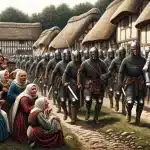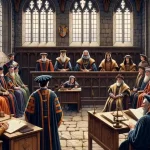Last Updated on 21/05/2025 by Alex Hamlyn
Table of Contents
English Witchcraft in the Shadow of the Reformation
This era, spanning from the 15th to the 18th century, truly marked a terrifying shift in the perception and persecution of alleged witches, fundamentally shaping the legal landscape and social anxieties of the time. his period, spanning from the late Middle Ages into the early modern era, saw the height of the witchcraft hysteria and the eventual decline of witch trials.
To truly grasp the intensity of this period, we must acknowledge the broader European context. While Britain had its unique trajectory, the “witch craze” was a continent-wide phenomenon, fueled by influential texts like the infamous Malleus Maleficarum (“The Hammer of Witches,” 1486). This German treatise provided a theological and legal justification for witch hunting, detailing how to identify, interrogate, and convict witches who were believed to have entered pacts with the Devil. While English law generally didn’t permit the same level of torture seen in some European inquisitions, the ideas about demonic pacts and the malevolent intent of witches certainly permeated British thought.
The religious upheavals of the Reformation were absolutely pivotal. The break from the Catholic Church led to an increased emphasis on scriptural literalism and a more intense focus on the Devil as an active force in the world. This created a fertile ground for suspicion, where misfortune could easily be attributed to diabolical machinations rather than divine will or natural causes. Protestants, in their zeal to “cleanse” society, sometimes viewed perceived witchcraft as a dangerous relic of the “old” religion, further fueling accusations.
From the Ecumenical to the Political
Politically, the shift in legal jurisdiction was a game-changer. Prior to the 15th century, witchcraft was largely considered a matter for ecclesiastical courts, treated as a sin rather than a secular crime. Accusations of witchcraft were still relatively rare and often linked to charges of heresy. The concept of witchcraft was becoming more associated with diabolism – the belief that witches made pacts with the Devil. The Witchcraft Act of 1542 under Henry VIII was the first to define witchcraft as a felony, a crime punishable by death and the forfeiture of the convicted’s goods and chattels. This marked a shift to more severe penalties for witchcraft.
The Witchcraft Act, though it would turn out to be short-lived, marked the initial move towards bringing such cases into the common law courts. Under the reign of Elizabeth I, the Witchcraft Act of 1563 was enacted, which lessened the punishment for witchcraft to imprisonment and pillorying for the first offense but retained death for a second offense that involved harm. The revised Act reflected a more nuanced approach to dealing with the issue of witchcraft in Elizabethan England. The 1563 Act made a distinction between different types of witchcraft and sorcery, which was a significant shift from the previous legislation under Henry VIII’s reign.
The death penalty was now reserved for cases where witchcraft resulted in someone’s death. Lesser offenses, such as causing harm or invoking evil spirits without causing death, were punishable by imprisonment or the pillory. This distinction showed a more measured approach to the issue, rather than treating all forms of witchcraft as equally deserving of the death penalty.
Elizabeth I, and her advisors, might have been wary of the social and political upheaval that could result from widespread witch hunts and executions. By enacting a law that was less harsh for minor offenses, the government could avoid the kind of mass hysteria and extensive witch hunts that were happening in some parts of Europe.
The 16th century was also a period of religious tension, following the Reformation and the establishment of the Church of England. Elizabeth I needed to balance the Protestant concerns about idolatry and superstition with the need to maintain order and avoid inflaming religious tensions further. The Act of 1563 was a way to address concerns about witchcraft without resorting to the extremes seen in some other countries.
It’s possible that the Renaissance, with its emphasis on humanism and a gradual shift towards more rational approaches to knowledge and law, was influential in drafting the Act. It could also have been entirely pragmatic. Elizabeth I’s reign was marked by a desire for stability and order after the tumultuous periods under her predecessors. Harsh laws and widespread persecution could have threatened the delicate balance she sought to maintain in her kingdom.
Two decades later, Reginald Scot’s ‘The Discoverie of Witchcraft’ (1584) publicly denounced the witch hunts and trials as irrational and unjust. Scot argued that belief in witchcraft and magic was superstitious and illogical.
The Rise of the Witch Hunter
There was still danger from the courts, however. The 1604 Act under James I. James, with his personal obsession with demonology as evidenced in his book Daemonologie (1597), actively encouraged the prosecution of witches. The 1604 Act, in particular, made it a capital offense to “entertain evil spirits” or use human corpses for necromancy, significantly broadening the scope for execution. This legal framework, with its emphasis on felonies and the removal of “benefit of clergy” (a legal loophole that sometimes exempted the accused from royal court jurisdiction), transformed witchcraft into a crime punishable by hanging, not burning at the stake (except in cases of petty treason). Death was still the penalty, though perhaps a little less horrific than before.
The Witchcraft Act of 1604 thus served to escalate an already tense environment, where accusations of witchcraft could be levied for a range of reasons – from personal vendettas to genuine beliefs in malevolent magic. The act also reflected and reinforced a broader cultural and religious context where the world was viewed through a Manichean lens of good versus evil, with witchcraft seen as a potent symbol of malevolence and heresy.
The mid-17th century, especially during the tumultuous English Civil War (1642-1651) and the subsequent Puritan era, saw the peak of witch hunting in England. This period of immense political and social instability, coupled with economic hardship, intensified fear and suspicion within communities. Figures like Matthew Hopkins, the self-proclaimed “Witch-Finder General,” exploited these anxieties, contributing to a surge in accusations and executions, particularly in East Anglia. Hopkins’ methods, though not involving the continental-style torture, often involved sleep deprivation and forced confessions, leading to numerous convictions.
This period also saw an increase in the number of witch trials and public executions, with the societal hysteria around witchcraft reaching its zenith. Notable witch trials of the era, such as the Pendle Witch Trials of 1612 and the Bideford witch trial of 1682, exemplified the heightened paranoia and judicial eagerness to prosecute those accused of witchcraft.
These trials did not exist in a vacuum. Witchcraft hysteria was also rising in the North American colonies, particularly in Salem, Massachusets. In Britain, the witch hunts of the 17th century became a defining moment in our history. It marked an era where legal, religious, and royal influences converged to create a climate ripe for persecution, deeply impacting the lives of many and leaving an indelible and shameful mark on the annals of British history.
As the 17th century drew to a close and into the early 18th century, skepticism began to grow. The legal system, with its jury trials and the absence of widespread judicial torture (unlike some European counterparts), faced increasing difficulties in proving witchcraft. The last known execution for witchcraft in England occurred in 1716, and by 1736, the Witchcraft Act was finally repealed.
This wasn’t necessarily because belief in magic had vanished, but rather because the legal and intellectual climate had shifted. The new Act instead focused on punishing those who pretended to have magical powers, essentially reclassifying them as con artists or vagrants. It was a fascinating transition, reflecting a move towards a more ‘enlightened’ legal and scientific perspective, even if popular belief in the uncanny lingered for much longer.
The story of British witchcraft is a potent reminder of how deeply intertwined religious belief, political power, and social anxieties can be in shaping the course of justice, or indeed, injustice.
Read more in this series
Witchcraft in Britain
An Introduction
Witches in Roman Britain
(1st-5th century)
Viking Britain and Witchcraft
(8th-11th century)
Medieval Britain and Witchcraft
(5th century onward)
Plantagenet and High Medieval Britain (12th-15th century)
17th Century: The Peak of Witch Hunts in Britain
Modern Britain And Witchcraft – As Strange As Ever
Witchcraft and the Celts
(Pre – AD43)
Witches in Saxon Britain
(5th-11th century)
Norman Britain and Witchcraft
(11th-12th century)
Early Modern Period and Restoration (15th-18th century)
Victorian Britain and Witchcraft
(19th-20th century)
Famous Witches in British History
(Plus one Witch Hunter)



